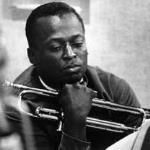
Many reviewers note the year of 1959 as perhaps the apex of modern (post-WW II) instrumental jazz, with at least three landmark albums symbolizing the era, and all issued on Columbia:



Kind of Blue – Miles Davis
Time Out – Dave Brubeck
Mingus Ah Um – Charles Mingus
There are also two other 1959 recordings (both issued on Atlantic) of note:
Giant Steps – John Coltrane
The Shape of Jazz to Come – Ornette Coleman
Both are noteworthy ….. in Coltrane’s case, it was more of an evolutionary album on his way to immortality (plus, it was actually released in 1960). The album by Ornette Coleman (who died just last month) by contrast, truly was revolutionary.
Yet as the touchstone for avant-garde jazz …… it would always be an acquired taste; with limited appeal (even among jazz fans). Plus, Atlantic Records had a reputation as an R&B label, whose jazz catalog did not begin to take off until the 1960’s. Lastly, none of the last two had a major re-issue in 2009 (its 50th anniversary).
The first three albums above benefited from Columbia’s marketing might (under the direction of Teo Macero), as they were the first to embrace the LP album in a major way. Also, the late 50’s was the dawn of the major retail record store, and also record clubs via mail. Finally, they were more representative of mainstream jazz … and each had a major 50th anniversary re-issue …. so let’s take a look at them, fifty-six years on.
It has been said about Kind of Blue that “People who have never bought another jazz album own this one.” Miles Davis was already a popular, known quantity in jazz for several reasons: (a) his sweet sound on trumpet, (b) he epitomized cool jazz which was more accessible than other post-modern types of jazz – in fact, he was the bandleader for the Birth of the Cool recordings a decade earlier – and (c), just as he had apprenticed with Charlie Parker and Dizzy Gillespie: he attracted sidemen of the first magnitude, able to raise the bar even higher.
Yet the sidemen he brought into the studio that day had no idea how popular the album they were to record would become. They were legendary, including saxophonist John Coltrane (already mentioned), Julian ‘Cannonball’ Adderley – whose sweet/soul sound on alto saxophone made him a popular bandleader later on, and pianist Bill Evans – considered among the best of his generation and who recorded with Tony Bennett later on.
This album’s innovation was its experimenting with modal jazz – keeping the background of a tune simple while soloists played a melody over one or two “modes,” or scales, instead of busy chord progressions – the usual harmonic foundation of jazz. Miles Davis gave his sidemen only basic outlines, and the music’s spareness gave them room to stretch-out. The songs tend to be long, and thus while my favorite is the slow All Blues – there is no “hit” song on this album; it is a concept-album without the concept …. meant to be heard in its entirety.
The result is the best-selling jazz album of all time and Rolling Stone ranked it as #12 on its 500 Greatest Albums of All Time.
Miles Davis died in September, 1991 at the age of 65. The one surviving performer on the recording is drummer Jimmy Cobb – who is still an active performer at age 86, and who said of the recording:
“It was just something that came along and clicked with everybody. It’s just probably a once-in-a-lifetime thing.”
By contrast, the album recorded by the Dave Brubeck Quartet entitled Time Out did have a hit single: Take Five reached #25 in the pop charts, and with its noteworthy “B” side, it was the best-selling jazz single of the 20th Century. Yet it is the collection of songs over the entire album that make it special:
a) All seven tunes on the album are in a time signature other than 4/4 or 3/4 (waltz).
b) None of them were danceable
c) The album cover was a painting; no photos of the band
d) It had other musical influences (one from Turkey, as will be noted).
In the words of Dave Brubeck:
“It’s wonderful because we were making an experimental album. I didn’t talk to anybody at Columbia because I knew they’d be against it. And they were: the sales force said it would never work and didn’t want to put it out”.
But the Quartet convinced one key person: Columbia president Goddard Lieberson – who approved the record saying, “We don’t need another copy of ‘Stardust’ or ‘Body and Soul’ – we’ve got so many. And it’s about time somebody did something like this.'”
The “B” side of Take Five was also a popular tune, Blue Rondo a la Turk – with the main part in 9/8 time, as Dave Brubeck heard that meter often on the streets of Istanbul, Turkey. “This rhythm is to us what the blues is to you”, he was told when he asked about the meter. Adding a 4/4 blues (in the key of F) as the improvisational middle section of the song … it became a rondo.
That single’s importance was summed-up by Keith Emerson – who years later became famous as part of Emerson, Lake & Palmer:
When I was 15 years old … that Christmas, my present from Mum and Dad was a single 45 vinyl record “Take Five”. On the B-side was “Blue Rondo a la Turk”. I played the hell out of it.
In 1968, I recorded a 4/4 version of Blue Rondo ….. and played the hell out of it in live performance.
Nowadays the album has its critics, believing it has become more of a Starbucks type of sound. Yet Steve Huey of the All-Music Guide writes, “As someone once said of Shakespeare: it’s really very good … in spite of the people who like it”. Dave Brubeck died in December 2012, one day short of his 92nd birthday. He and his wife Iola (his sometimes lyricist) were married 70 years.
The Quartet’s one surviving member is bassist Eugene Wright at age 92. The band had to cancel appearances during the 1950’s Jim Crow era because they would not substitute a white bassist for Wright.
The third album in this trilogy merits inclusion (according to most critics) for these reasons: (a) it is considered the nonpareil bassist Charles Mingus’ greatest album release during his lifetime, at least for non jazz-buffs, (b) like Time Out, it has a one-two punch of songs among Mingus’ best and (c) it is also his most autobiographical: with tributes to Edward Kennedy Ellington (“Open Letter to Duke”) and to the earliest jazz composer of note, Jelly Roll Morton (“Jelly Roll”). Charles Mingus was known for having a volcanic temper at times, yet this album also shows his gentle side – and anyone wishing to study the man’s music should begin here.
The first of the two songs that opened the album (the first Mingus recorded for Columbia) tune was Better Get It in Your Soul – a rollicking song in 6/8 time punctuated by Gospel-like shouts and hand-clapping – that remains eternally joyful, and which Mingus featured in many concerts. (You can hear it at this link to see why).
The second was a very timely one: one of the most elegant (yet sophisticated) elegies you will ever hear. Not long before these recording sessions, one of the most important tenor saxophonists in jazz (Lester Young) had died, who was an essential partner of singer Billie Holiday: he nicknamed her “Lady Day”, and she in turn nicknamed him “Prez” (short for president). Mingus entitled his tribute after the chapeau Lester Young favored, and Goodbye, Pork Pie Hat has been recorded by numerous performers. For rock music fans, Jeff Beck has a noteworthy 1970’s version, and Joni Mitchell (with the assistance of Charles Mingus) wrote and sang lyrics to this tune.
Other tunes on the recording include the swinging “Boogie Stomp Shuffle” and his autobiographical “Self-Portrait in Three Colors”. Charles Mingus died in 1979 (at the age of 56) not long after appearing at a White House outdoor show with President Carter.
The surviving musicians on the album include tenor saxophonist Shafi Hadi and pianist Horace Parlan, who are no longer active musicians (Horace Parlan lives in an assisted living facility in his adopted country of Denmark at age 84). The one still-active musician is saxophonist John Handy who lives in the Bay Area at age 82.
It is very likely that if your public library has any amount of jazz CD’s: that at least one of these three will be among them. If so, listen to them either in your vehicle or as background music – but let them play whole, not listening at rapt attention. Chances are, even if jazz is not your music: you will understand why these three have stood the test-of-time.
Let’s close with one of the songs from Mingus Ah Um. I mentioned the timeliness of “Goodbye Pork Pie Hat” – there was also another timely song, and (uncommonly for Mingus) overtly political.
It was a condemnation of Arkansas governor Orval Faubus – who in 1957 had ordered the state’s National Guard to prevent the integration of Little Rock Central High School by nine African-American teenagers, with President Eisenhower dragging his feet for a time. This resulted in the normally placid (and to many African-Americans, timid) Louis Armstrong losing his temper over racial segregation.
In response, Mingus recorded Fables of Faubus with scathing lyrics … that Mingus left out on the original recording at the behest of Columbia executives (concerned about Southern record buyers of the day) and appears as an instrumental.
A year later, he re-recorded the song on the (independent) Candid Records label, produced by future Village Voice writer Nat Hentoff – this time, with lyrics (in them, he references his long-time drummer, Dannie Richmond).
At this link is the original instrumental (and, in fairness, better-recorded and much more smooth sounding). And below you can hear the remake (with lyrics).
Oh, Lord, don’t let ’em shoot us!
Oh, Lord, don’t let ’em stab us!
Oh, Lord, don’t let ’em tar and feather us!
Oh, Lord, no more swastikas!
Oh, Lord, no more Ku Klux Klan!Name me someone who’s ridiculous, Dannie.
(Governor Faubus!)
Why is he so sick and ridiculous?
(He won’t permit integrated schools.)Then he’s a fool! Boo! Nazi Fascist supremacists!
Boo! Ku Klux Klan (with your Jim Crow plan)Name me a handful that’s ridiculous, Dannie Richmond.
(Faubus, Rockefeller, Eisenhower)
Why are they so sick and ridiculous?(Two, four, six, eight:
They brainwash and teach you hate).
H-E-L-L-O, Hello.







Your thoughts and observations?
Great diary,. Really interesting. Thanks.
Awwww…you just shot me back in time – Thank you!